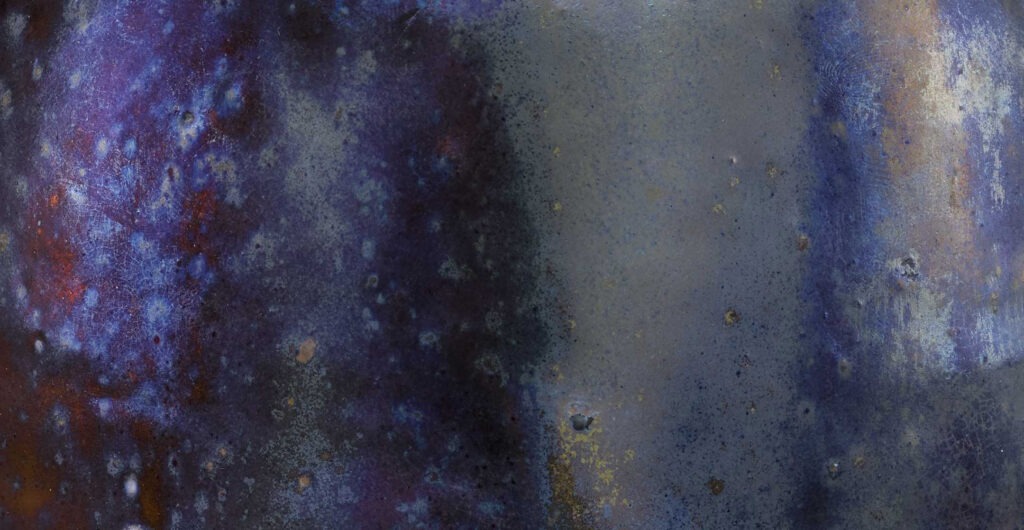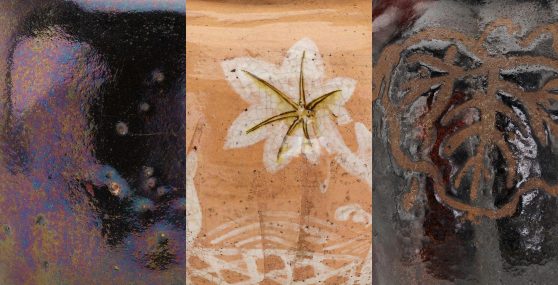December 9, 2023–2026
-
Dates
-
Location
Freer Gallery of Art | Gallery 20a
-
Collection Area
Japanese Art
Japan’s rich history of ceramic artistry developed in large part alongside the culture of drinking tea. The practice of preparing and serving matcha, powdered green tea, was called chanoyu (literally, “hot water for tea”) and gained popularity in the sixteenth century. Japanese tea practitioners initially used Chinese and Korean antique ceramics as tea bowls but began using newly made Japanese tea bowls, such as Raku ware, in the sixteenth century. Raku ware shares its name with the family that has made these ceramics in Kyoto since the sixteenth century. Unlike most tea bowls, Raku ceramics are built by hand—a process described as “knotting clay”—as opposed to using a wheel. Sixteenth-century potters are said to have collaborated closely with their tea-practitioner patrons to create distinctive vessels best-suited for tea drinking.
Over the next four centuries, a network of Japanese potters incorporated Raku techniques into their practice; these techniques were later adopted in the 1950s by the American studio pottery movement. Raku wares are now internationally recognized as a Japanese ceramic style and continue to inspire artistic creativity worldwide. Knotted Clay: Raku Ceramics and Tea explores these distinctive, hand-molded ceramics and their close relationship to Japanese tea culture. This exhibition features tea bowls, water containers, and other vessels in the museum’s permanent collection that demonstrate the glazes and forms unique to Raku ware.
Art Stories | Iridescence
The low-fired iridescent glaze is perhaps the most visually striking and recognizable aspect of Raku ceramics. From shiny stones to glittering insect wings, from shimmering feathers to glistening shells, from accidental patinas to clever ceramic glazing techniques, iridescence in its various forms has captivated artists and collectors across the ages. Discover how this play of color occurs and see objects in our collections from new angles.

Related Exhibitions
-

Reasons to Gather: Japanese Tea Practice Unwrapped
April 12, 2025–April 26, 2026
-

Japanese Art from the Collection
October 26, 2024–ongoing
-

Striking Objects: Contemporary Japanese Metalwork
March 2, 2024–January 11, 2026
Composite image: Tea bowl, named Ubatama (Black berry) (detail), style of Hon’ami Kōetsu (1558–1637), Japan, Kyoto prefecture, Kyoto, Edo period, 19th century, Raku ware, unknown workshop, earthenware with Black Raku glaze, F1898.437a–b; Kenzan-style Red Raku water jar with design of maple leaves and gabions (detail), imitation of Ogata Kenzan (1663–1743), Japan, Kyoto prefecture, Kyoto, Meiji era, late 19th century, Raku ware, unknown workshop, red clay; white slip, iron pigment under transparent lead glaze, F1900.118; Black Raku incense burner in “melon” shape (detail), imitation of Ogata Kenzan (1663–1743), Japan, Kyoto prefecture, Kyoto, Meiji era, 19th century, Raku ware, unknown workshop, buff clay; black glaze, copper-red glaze accent, F1907.524a–b. All three objects Gift of Charles Lang Freer, Freer Gallery of Art, National Museum of Asian Art, Smithsonian Institution.
- Jump To...
Explore All Pieces in this Section
Ohi ware shallow tea bowl
-
Period
Edo period
-
Geography
Kanazawa, Ishikawa prefecture, Japan
-
Material
Earthenware with amber lead glaze; gold lacquer repair
-
Accession
F1897.61
Tea bowl named "Ubatama" (Black Berry), unknown Raku ware workshop
-
Period
Edo period
-
Geography
Kyoto, Kyoto prefecture, Japan
-
Material
Earthenware with Black Raku glaze
-
Accession
F1898.437a-b
Tea bowl, named "Omokage" (Memory), unknown Raku ware workshop
-
Period
Edo period
-
Geography
Kyoto, Kyoto prefecture, Japan
-
Material
Raku-type clay with Black Raku glaze
-
Accession
F1898.443
Kenzan-style Black Raku water jar with design of maple tree
-
Period
Meiji era
-
Geography
Kyoto, Kyoto prefecture, Japan
-
Material
Buff clay; black lead glaze, enamel over glaze
-
Accession
F1899.100a-b
Tea bowl, copy of Kaga Koetsu, named Chigusa, unknown Raku ware workshop
-
Period
Edo period
-
Geography
Kyoto, Japan
-
Material
Earthenware with red slip under clear lead glaze
-
Accession
F1900.81
Kenzan-style Red Raku water jar with design of maple leaves and gabions
-
Period
Meiji era
-
Geography
Kyoto, Kyoto prefecture, Japan
-
Material
Red clay; white slip, iron pigment under transparent lead glaze
-
Accession
F1900.118
Black Raku tea bowl, copy of "Shishi" by Raku Do'nyu
-
Period
Edo period
-
Geography
Kyoto, Kyoto prefecture, Japan
-
Material
Earthenware with Black Raku and colorless glazes
-
Accession
F1901.2
Faceted candy-pellet bottle with design of drying nets, unkown Raku ware workshop
-
Period
Edo period or Meiji era
-
Geography
Japan
-
Material
Earthenware with Red Raku glaze and white glaze; red lacquer repair
-
Accession
F1901.80
Tea-ceremony water jar with matching lid in imitation of Hon'ami Koetsu, unknown Raku ware workshop
-
Period
Edo period or Meiji era
-
Geography
Tokyo, Japan
-
Material
Earthenware with Red Raku glaze, mother-of-pearl and metal inlay; gold lacquer repairs
-
Accession
F1901.111a-b
White Raku tea bowl with facets
-
Period
Meiji era
-
Geography
Kyoto, Kyoto prefecture, Japan
-
Material
White clay; white slip, iron pigment under transparent lead glaze
-
Accession
F1902.211
Black Raku incense burner in "melon" shape
-
Period
Meiji era
-
Geography
Kyoto, Kyoto prefecture, Japan
-
Material
Buff clay; black lead glaze, copper-red glaze accent
-
Accession
F1907.524a-b
White Raku tea bowl, named Hekidō
-
Period
Taisho era
-
Geography
Japan
-
Material
Earthenware, Raku glaze
-
Accession
F2019.5.1a-j
Shallow tea bowl
-
Geography
Japan
-
Material
Earthenware with milky ash glaze
-
Accession
F2019.5.4a-f
Black Raku tea bowl with pine motif
-
Period
Taisho era
-
Geography
Kyoto, Japan
-
Material
Earthenware with Black Raku glaze
-
Accession
F2019.5.5a-k
Black Raku shallow tea bowl, named Tagoto no Tsuki (Moon in each rice field)
-
Period
Edo period
-
Geography
Kyoto, Japan
-
Material
Earthenware with black Raku glaze
-
Accession
F2019.5.6a-j
Red Raku cylindrical tea bowl in the manner of Kōetsu
-
Period
Edo period
-
Geography
Kyoto, Japan
-
Material
Earthenware with Red Raku glaze
-
Accession
F2019.5.7a-j



